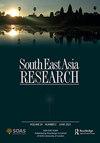Plant recognition by Northern Khmer children in Ban Khanat Pring and Ban Ramboe Villages, Surin Province, Thailand
IF 0.9
3区 社会学
0 ASIAN STUDIES
引用次数: 0
Abstract
ABSTRACT This article arises from a project that explores the acquisition of ethnobotanical knowledge in Northern Khmer-speaking communities in northeast Thailand, in response to the wish expressed by villagers to preserve their knowledge of the surrounding Takah Forest. This phase of the project consisted of a quantitative pictorial recognition test, using photographs of 111 plants previously documented, with twenty-eight young participants from Ban Khanat Pring and Ban Ramboe villages. We found that useful plants (edible or medicinal) are the most frequently recognized. We tested the significance of social factors, gender and age group for predicting plant recognition among children. We found no significant difference in the scores according to gender, but counter to our expectations, the Bayesian statistics reveal it is extremely likely (91% probability) that younger children recognize more plant tokens than older children. These results suggest an erosion of local ethnobotanical knowledge as children enter their teenage years. Individual variability in recognition is further examined in the project’s next phases, using interviews with the children and the ethnographic knowledge of each child’s family. This study will serve in developing initiatives with the communities that can enhance knowledge transmission and maintenance among this group.泰国素林省Ban Khanat spring村和Ban Ramboe村的北高棉儿童对植物的认识
本文源于一个项目,该项目探讨了泰国东北部北部高棉语社区的民族植物学知识的获取,以响应村民表达的保护他们对周围Takah森林知识的愿望。该项目的这一阶段包括定量图像识别测试,使用先前记录的111种植物的照片,来自Ban Khanat spring村和Ban Ramboe村的28名年轻人参加了测试。我们发现有用的植物(可食用或药用)是最常被识别的。我们测试了社会因素、性别和年龄组对预测儿童植物识别的重要性。我们发现,根据性别,得分没有显著差异,但与我们的预期相反,贝叶斯统计数据显示,年龄较小的儿童极有可能(91%的概率)比年龄较大的儿童认识更多的植物符号。这些结果表明,随着儿童进入青少年时期,当地民族植物学知识受到侵蚀。在项目的下一阶段,通过对儿童的访谈和每个儿童家庭的民族志知识,进一步检查识别方面的个体差异。这项研究将有助于与社区一起制定倡议,加强这一群体之间的知识传播和维护。
本文章由计算机程序翻译,如有差异,请以英文原文为准。
求助全文
约1分钟内获得全文
求助全文
来源期刊

South East Asia Research
ASIAN STUDIES-
CiteScore
1.90
自引率
0.00%
发文量
42
期刊介绍:
Published three times per year by IP Publishing on behalf of SOAS (increasing to quarterly in 2010), South East Asia Research includes papers on all aspects of South East Asia within the disciplines of archaeology, art history, economics, geography, history, language and literature, law, music, political science, social anthropology and religious studies. Papers are based on original research or field work.
 求助内容:
求助内容: 应助结果提醒方式:
应助结果提醒方式:


